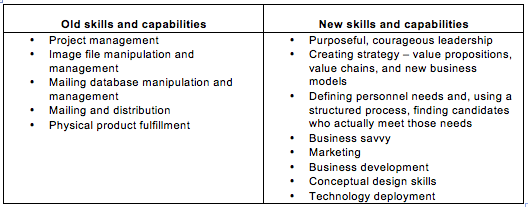I started my last article with two questions. Does your company matter in the market? If your customers got up next Monday morning and discovered your business was no longer open, would you be missed?
In summary point format, we discussed the following:
- The current state of the industry puts us in the third phase of the industry lifecycle. Managing this phase requires us to accomplish 5 fundamental tasks. (See my article, Does Your Company Have a Magnet?) This may be our industry’s biggest challenge ever.
- Most of 21st century marketing practice revolves around the web site. The web site should be thought of as amagnet. There are several ways to improve its attracting power.
- Where once there were the “Big 3” – television, radio, and print; there are now 50+ media channels you can use to reach your target audience. Finding your target audience in this context is a real challenge…one that marketers are only beginning to figure out. The role of print is changing. It is no longer central as one of the driving media forces. It is now a specialty that reinforces and supports many others.
- I gave you 4 recommended actions to take.
- Having a good magnet, while very helpful, is not enough. We need something beyond that function like a lightning rod – pulling the energy in the market to you!
To survive, most of us will need to make the transition to some reinvented form. A critical key to this change will be how we do with the challenge of becoming good marketers. Within the strategic context of the industry described in my last article, there was a pretty good summation of 21st century marketing thought and practice. It will take some work to master this.
A good web site and becoming good marketers are not enough, however. Our industry has been plagued for years by very low profitability. Michael Porter (See my article, What Would Michael Porter Think?) tells us that low profitability is linked to poor strategy. In his definition of good strategy we compete for profits by being unique…not being the best or the biggest.
A robust, well executed strategy gives your companyuniquenessin the market and generatessuperior profitability. A robust strategy attracts the energy in the market. Customers are drawn by the unique value created within the strategy. Superior execution of the value chain created to deliver this unique value attracts a disproportionate share of the profits available in the market.
Creating good strategy is the centerpiece to surviving and thriving as we transition from a shrinking, low profit industry to something new. That something new will be a business model that merges skills and capabilities we’ve always had (not necessarily the printing hardware and
process) with new skills and capabilities. The following table lists some of those old and new skills/capabilities that, in many cases, will be found in new business models of companies that transition away from the old to the emerging new.

The lists are not intended to be complete nor accurate in an absolute sense. However, there is some solid stuff here. I hope you will ponder these attributes, learn more about them, and, ultimately, act on them. Again, while not complete, these attributes are the fundamentals of being entrepreneurial in a chaotic, turbulent environment. If you need a place to start thinking about what your company will need 3-5 years from now…try these for starters.
Let’s talk for a minute about one of these – creating strategy. There are three major pieces of a good strategy:
- The customer value proposition
- A unique value chain that marries the needed resources and processes together to create unique value and superior profits.
- The profit formula that ties, in economic terms, the value proposition that drives demand, revenues, and pricing levels together with the value chain and its costs, investments, and outcomes.
All of these pieces have a number of components that must be developed individually and then woven together to create the final result. Finding, attracting, and developing customers can be done with a good web site, good marketing, and good business developers on your sales team. Creating long-term loyal customers and generating superior profits is a step higher. This requires a value proposition, a unique value chain, and a profit formula. Done well, you have a robust strategy which, in turn, leads to superior profitability. They are two sides of the same coin.
If you had a good strategy in place, would your company matter?















Discussion
Join the discussion Sign In or Become a Member, doing so is simple and free